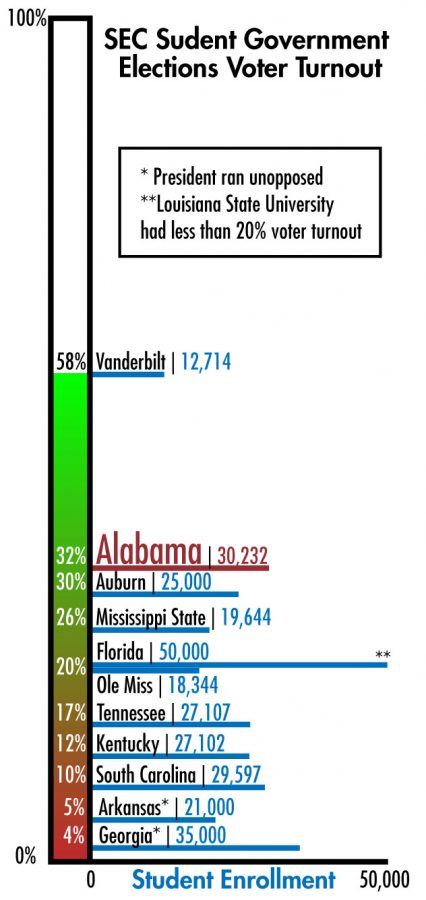After weeks of hard work campaigning, debating and examining the issues to choose the most qualified candidates, Student Government Association elections are over.
At least 32 percent of students chose to vote. Excluding the presidential election, the executive offices were unopposed this year, so the winners were settled before the race began.
This turnout is relatively high for Southeastern Conference schools.
Only 4 percent of approximately 35,000 students voted in the most recent election at the University of Georgia. Ed Mirecki, SGA adviser at UGA, said this low turnout was rare and well below the average. UGA usually participates in a party system where the president, vice president and treasurer run on one ticket with a group of senators. Since a single party ran unopposed this year, the winners of the election were predetermined, much like the majority of the UA executive positions, and voter turnout was low.
“Eighteen percent of the student body voted last year,” Mirecki said. “This is more typical of what we usually see. Our numbers fluctuate between 18-20 percent. In talking about SGA elections in general across the country, that seems to be on the high end of things.”
University of Arkansas SGA Adviser Jessica Morgan said they also experienced a drop in voter turnout, topping out at 5 percent of 21,000 students, because three of the four executive positions were uncontested.
“We usually have at least two candidates for each position,” Morgan said. “Last year, one of the presidential candidates was disqualified and a vice presidential candidate dropped out with him.”
Troy Jackson, the attorney general for the Associated Student Body at the University of Mississippi, said the number of candidates and level of competition definitely correlates to increased voter turnout. Around 20 percent of students at Ole Miss voted in their most recent election.
“Personally, I think 20 percent is very low voter turnout,” Jackson said. “The national average is around that percentage [with young adults being the least active], so I guess it’s normal. I think other SEC schools will have around 20-25 percent voter turnout. It’s hard to get students motivated and caring about programs when they have hundreds of other things going on.”
Jackson said one way to increase turnout is to spotlight what the ASB is doing to improve student life.
“If more students understood how much the ASB has affected their time at college and how much they can do with ASB in the short amount of time they are here, people will be more inclined to look at issues and make an educated decision during the election,” Jackson said. “Ole Miss is so diverse, and it makes it difficult to connect with every single person. However, we share, like other SEC schools, a bond with our university; and it is up to students to make sure this bond is strengthened and never broken.”
Laurel Parker, student government elections commissioner for the University of South Carolina, attributed a low turnout of less than 10 percent of the student body in the last general election to a clean race, The Daily Gamecock reported.
“It was very respectable, and it’s sad, but a lot of students want scandal,” Parker
said, according to The Daily Gamecock. “That drives more people to vote.”
Another aspect of the percentage of students voting in SGA elections is the method in which they are asked to vote.
Rhett Hobart, student association president at Mississippi State University, said they transitioned to a complete online election this past year and eliminated the need for students to go to a polling station to vote. As a result, they experienced a vastly increased turnout in every election including senate and homecoming.
“We were excited that roughly 26 percent of the student body voted because we want to do our best to make sure the most students can vote in our elections and that the most students possible have a voice,” Hobart said.
The University of Florida still uses a paper-and-pencil ballot system where students can go to the polls at different locations on campus. The president and vice president run on a single ticket together, so if one wins, they both win. Following along with the average, UF had a 20 percent turnout in elections this year.
The University of Tennessee had a 17.2 percent voter turnout, and Auburn University reported 30 percent, just two percentage points behind the University of Alabama. Vanderbilt University sets the record for the highest voter turnout in the SEC, with 58 percent of their 12,714 students voting.
When the University of Alabama first began using the online voting system in 2009 the percentage of students voting jumped from 5,240 to 14,469 or 56 percent of campus. However, this leap could be attributed to the controversial election between Steven Oliver and Kendra Key.
In 2010, 28 percent of students voted online, according to Kelli Knox-Hall, senior assistant director of the Ferguson Center and convener of the SGA elections board.
“Just a click of a button sitting in your dorm room could sway the vote,” said Molly Griffin, a junior majoring in political science. “It’s your civic duty as an active member of society to vote, and if you choose not to, you have no room to complain when people make decisions you don’t agree with.”
While the University of Alabama is above average at 32 percent, some students said they believe the turnout is still not high enough.
“It’s sad that only 32 percent of students voted in the election,” said Courtney McAdams, a sophomore majoring in secondary education. “Even if a student writes in their candidates, they should at least vote.”










